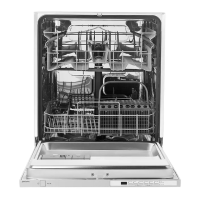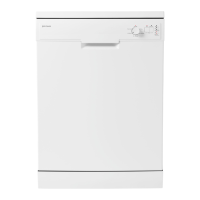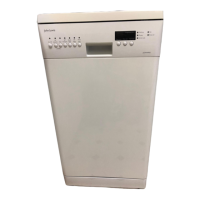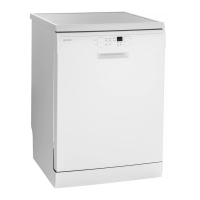Do you have a question about the John Lewis JLBIDW 902 and is the answer not in the manual?
Precautions and requirements for safe installation of the appliance.
Measures to ensure children's safety around the operating appliance.
Guidelines for the intended household and similar applications of the appliance.
Overall safety advice for users, covering operation and potential hazards.
Identification and labeling of the main parts of the dishwasher.
Explanation of the floor indicator light for programme status and malfunctions.
Overview of the control panel, including buttons, display, and indicators.
Explanation of the On/off, Programme, and Delay start buttons.
What the display shows: water softener, programme duration, rinse aid, etc.
Meaning of salt, rinse aid, multi-tab indicators and acoustic signals.
How to enter setting mode and activate/deactivate acoustic signals.
Details of available programmes: Rinse hold, Automatic, 70° Intensive, Quick, 50° Eco.
Data on duration, energy (kWh), and water (litre) consumption for each programme.
Steps to follow before the first use, including checks and initial fills.
How to adjust the water softener based on local water hardness levels.
Procedure for manually adjusting the water softener using the dial.
Procedure for electronically adjusting the water softener via buttons.
Instructions for correctly filling the salt reservoir with dishwasher salt.
Guidance on filling the rinse aid dispenser and adjusting its dosage.
Tips for loading dishes and cutlery, including what not to wash.
List of items that should not be washed due to material or construction.
Items requiring caution or special handling during dishwasher washing.
Specific guidance for loading pots, pans, and dishes in the lower basket.
Safe and effective methods for placing cutlery in the cutlery basket.
Arrangement of glasses and other items in the upper basket for optimal cleaning.
How to change the height of the upper basket to accommodate larger items.
Procedures for moving the upper basket between lower and higher positions.
Recommendations for using dishwasher detergent and its quantity.
Step-by-step instructions for adding detergent to the dispenser.
Instructions for removing and cleaning the appliance filters for optimal performance.
Guidance on cleaning external surfaces, internal components, and spray arms.
Advice for non-operation, frost precautions, and moving the appliance.
Table of common issues, their possible causes, and solutions.
Explanation of alarm codes displayed by the appliance during malfunctions.
Solutions for issues like dishes not clean, limescale, or streaks.
Procedure to activate the rinse aid dispenser when using the Multi tab function.
Details on appliance dimensions, water pressure, and electrical connection.
Information on place settings and power usage in different modes.
Crucial warnings regarding appliance modification, weight, and electrical/plumbing work.
Steps for unpacking the appliance and positioning it near water and drain connections.
Importance of proper levelling for door closure and sealing, with adjustment steps.
Ensuring the appliance is secured against tilting by fixing it to surrounding structures.
Guidelines for connecting the appliance to the water supply, including pressure and hose tips.
Methods for connecting the drain hose to a sink spigot or stand pipe.
Details on sink plug usage, drain hose extensions, and under-sink trap connections.
Mandatory safety standards including earthing, plug accessibility, and fuse replacement.
Correct procedures for plugging in, unplugging, and replacing the electrical cable.
Information on the three-year warranty and contacting John Lewis technical support.
Details required when contacting a local service engineer for repairs.
Emphasis on using only genuine spare parts and avoiding self-repair.
| Type | Freestanding |
|---|---|
| Energy Efficiency Class | E |
| Wash Programs | 6 |
| Width | 60cm |
| Quick Wash | Yes |
| Time Remaining Indicator | Yes |
| Delay Start | Yes |
| Half Load Option | Yes |











